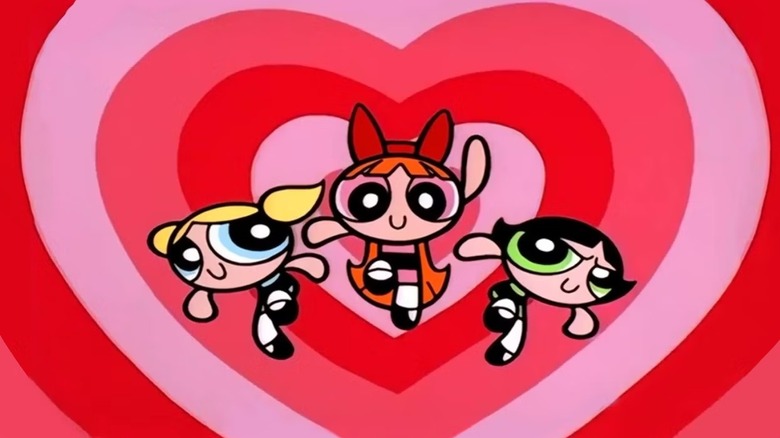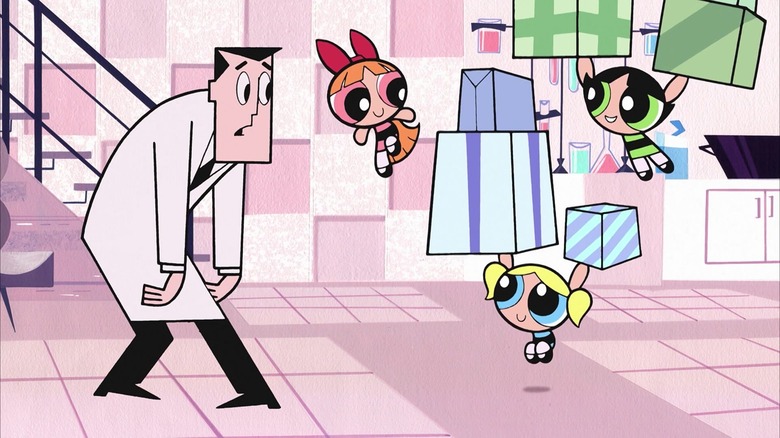The Powerpuff Girls Became A Timeless Hit Thanks To Another Cartoon Network Series
Prior to the debut of "The Powerpuff Girls" in 1998, show creator Craig McCracken had directed a series of tasteless cartoon shorts starring a character named No-Neck Joe. No-Neck Joe appeared regularly at the celebrated annual Spike & Mike Sick and Twisted Festival of Animation, cementing McCracken's underground credentials. The Powerpuff Girls first came into McCracken's repertoire as early as 1992, back when they were called the Whoopass Girls. The juxtaposition between the characters' creepy, ultra-cute, Margaret Keane-like faces and their ultra-violent behavior was the stuff of comedy legend, and McCracken kept the Girls in his back pocket for years.
Throughout the 1990s, McCracken rose in the ranks of the animation world, landing gigs on shows like "2 Stupid Dogs," "Dumb and Dumber," and, most notably, Genndy Tartakovsky's seminal series 1996 "Dexter's Laboratory." McCracken directed many episodes of the show. "Dexter's Laboratory" was one of four new series launched by the Cartoon Network in the late 1990s that redirected the company to be more creator-driven. The other three shows were Van Partible's "Johnny Bravo," David Feiss' "Cow and Chicken," and McCracken's "The Powerpuff Girls."
According to a 2023 retrospective by the Los Angeles Times, McCracken's original 1995 pitch for "The Powerpuff Girls" (no longer Whoopass) tested incredibly badly. A pilot — "Meat Fuzzy Lumkins" — was shown to a panel of 11-year-old boys, and the kids rejected it outright, calling it the worst cartoon they had ever seen, and arguing that its creator should be fired. McCracken was certain his career was over, but, quite luckily, he was able to go back to storyboarding episodes of "Dexter's Laboratory."
It was after the initial rejection that his work finally caught the eye of a wandering exec. Rather unexpectedly, McCracken gained an ally.
The worst show ever
McCracken's story is a testament to persistence. He continued to pitch "The Powerpuff Girls" for years, was rejected, and went back to work, but still got the attention of an executive. In McCracken's case, it was Linda Simensky, the Senior Vice President of Animation at the Cartoon Network. She was already overseeing "Dexter's" and saw a lot of promise in McCracken ... even after his pitch had failed. Simensky kept on encouraging McCracken to keep the Powerpuff Girls alive and used her position to talk to Mike Lazzo, then the Executive in Charge of Programming.
Lazzo was one of the masterminds of "Space Ghost Coast to Coast," Cartoon Network's Dadaist talk show hosted by an old, disused Hanna-Barbera character. He would go on to oversee shows like "Harvey Birdman, Attorney at Law," "Sealab 2021," and "Aqua Teen Hunger Force" over at Adult Swim. Lazzo had an ear for weird s*** and knew an idiosyncratic animator when he met one.
Simensky pushed McCracken in Lazzo's direction and history was made. Lazzo responded well to "The Powerpuff Girls," and the show was finally put into production. The new series debuted on November 18, 1998, and it was a smash hit. It ultimately ran for six seasons and 78 episodes, eventually spinning off into a theatrical feature film in 2002. The show also won three Emmys and spawned an anime spinoff, as well as multiple video games. In 2020, it was announced that a live-action "Powerpuff Girls" series was in the works, but that project has since been canceled.
McCracken went on to create "Foster's Home for Imaginary Friends," "Wander Over Yonder," and the Netflix series "Kid Cosmic." He has recently been shopping around a "Powerpuff Girls" reboot series in Europe.
Be good at your job, be persistent, and you will be noticed. It can happen.

